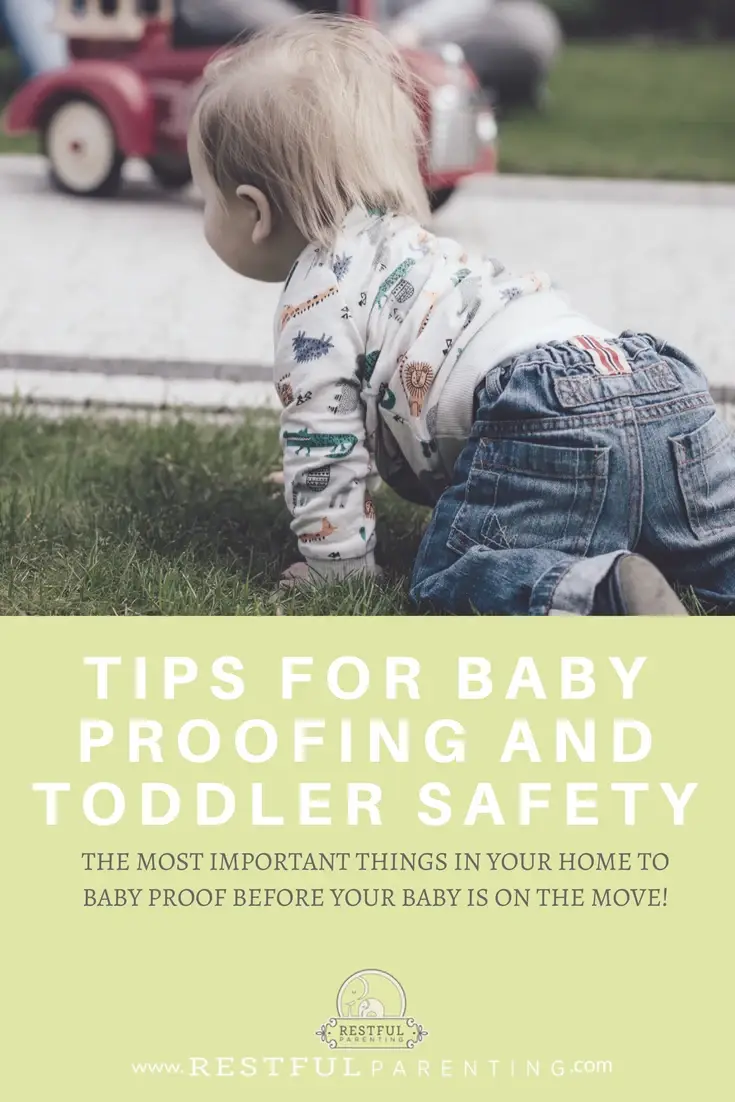Babies on the move and toddlers learning to climb can get into anything and everything! All it takes is a few seconds with your back turned for your child to show you what kind of trouble they can get into! Before your baby begins to crawl and walk, you will need to consider what needs to be baby proofed in your home! There are so many safety products available- it can be overwhelming! We’ve compiled some tips for baby proofing your home and keeping your toddler safe!
How much you baby proof your home will depend on your home, your child and your parenting style. Generally speaking, we tend to focus more on teaching the children what they can and can’t touch- however baby proofing the major hazards is important.
THE MOST IMPORTANT THINGS IN YOUR HOUSE TO BABY PROOF:
Baby Proofing in the Kitchen:
- The dishwasher can be a hazardous place for little ones with easy access to knives and pointy forks.
I always point my knives downward and don’t fill it with soap until you are ready to turn it on. - Medicines, household cleaners, laundry pods and dishwasher pods or detergent should be locked and preferably stored up high.
- When cooking, place pots and pans with handles inwards so they cannot be grabbed or knocked over.
Ensure that you don’t have dangerous items within toddler reach on counters (knives, heavy plates, slow cooker (the slow cooker is a big one.) - Install anti tip brackets on your oven (or check to make sure one is already installed)- little ones like to try to hang from the oven door handle and could cause whole stove to topple over.
- Outlets. For sure any outlet that they can reach. Those wet little fingers can and will try to touch!
Knives, sharp objects they can hurt themselves on- as an example, I don’t put locks on all of my kitchen drawers, but I do put all knives and sharp objects up high.
Baby Proofing In the Bedrooms:
- Window cords is a huge one. Place crib away from any cords, cords in playrooms, other rooms where your child will be.
- Outlets. As mentioned above.
- Another big hazardous item that may go unnoticed are those video baby monitors. If you use a camera monitor with cords, make sure that the cords are not close to your little one’s bed or within reach. Mount it on the wall or place it on a dresser out of reach. The cords from those monitors can be a huge hazard in or near their beds.
- Tall dressers, cabinets and shelves should be anchored to the walls! Open dresser drawers can cause a seemingly stable dresser to tip over. Use a simple ‘L bracket’ or a roll of All Round Strapping to screw the furniture to the wall.
- If you use a humidifier, make sure it is always filled with water when you turn it on. Also, you can buy ones that have a sensor to alert you if are empty.
- Crib mattresses should fit the bed frame correctly-gaps that are too big can be hazards.
- Baby oil, Vaseline, and baby powder can be a danger to children if swallowed. Keep them out of reach!
- Transitioning to a big kid bed-In addition to the safety tips above, we would keep the things in their room very minimal so that there is less for them to get into. Do a scan of their room before sleep periods to make sure that there is nothing dangerous that made its way in! If you can, cover the outlets that have things plugged in -such as sound machine or monitor- covered with a dresser or the change table so they cannot play with the cords or outlets. We would also put a gate up on their bedroom door so that they cannot explore the house in the middle of the night. If they don’t like having the gate up which most children do not, put it on their door once they are asleep. Or place the gate in the hallway nearest to their room so that they cannot go down the stairs or into another room. Close all of the rest of the doors.
Baby Proofing the Common Areas of your home:
- Stairs: Install a hardware mounted gate at the top of the stairwells, pressure gates can be used at the bottoms of stairwells. The issue with the pressure gates is that they can be pushed over with enough strength and if that is right next to the stairway and going down the stairs, well we know what could happen. So you want a gate that mounts into your wall with hardware to prevent this issue.
- Front door bolt for homes with toddlers. Lever door handles can be very easy for toddlers to open! When you have little ones that are out of a crib and tall enough or old enough to figure things out, you will want to have a bolt on your front door so that they cannot escape throughout the night or during the day for that matter. Some littles are very curious and like to experiment, discover or push some boundaries!
- Add a bell to the front door so you can hear if your child tries to open it. Bells on the door handle was and still is one of the best ideas we did. We had just moved to our new house and my daughter was just over 2 and while I was upstairs going to the bathroom she opened the door and let herself out. From that day forward, I put a bell around the handle so regardless of where we were in the house, we could hear the door opening!
- Doorknob covers on important doors like the bathroom and laundry room.
- Worth mentioning again, cabinets, shelves and TV stands should be anchored to the walls! Use a simple ‘L bracket’ or a roll of All Round Strapping to screw the furniture to the wall.
- Outlets. In every room where they can reach them!
- Indoor plants-if you have potted plants, make sure they are not poisonous if ingested. Place them up high if needed. Not sure what those plants are? Here is one resource and another you can check out. Fertilizers and soil additives can also be poisonous, so if in doubt place the plant out of reach or get rid of it.
Safety Tips for Outside the Home
- When watching your children outside, position yourself so that you are near the forbidden area, like the street end of the driveway. So if we are using the road for instance, I would sit or stand close to the road watching the children play on the driveway. If anyone decided to go onto the road, I am close enough to grab them as quickly as possible. Instead of me having to run from the walkway down to the road.
- If you have a waterfront or creek as a hazard close by, if you cannot put up proper fencing, consider putting up a snow fence or picket fence to provide a barrier. It may not be pretty but even if it’s only for a season or two having a temporary fence may help. Although it would not keep a determined toddler out of danger completely, it would help in teaching him or her boundaries (even at a young age).
- Another way to teach boundaries is to grab a can of spray paint (again, not overly pretty) and paint a line in the yard and continuously talk to him about the dangers and not being able to cross that line. Of course, it is going to take a lot of repeating and won’t be an instant solution but if you start small and really reinforce the boundaries, it will help down the road.
- Practice outdoor outings! We always took our children to a safe place (pathway, field, etc) to work on walking beside us or holding onto the stroller. We would practice many times in a very safe area before making outings onto the busy sidewalks and roads. This helped so much as we prepared them.
- Be aware of any outdoor plants that can be a hazard- whether it’s thorns or poisonous plants. Also keep any fertilizers, soil additives out of reach.
- Make it fun by walking in the trail and playing the listening game; stop when I say stop, run when I say run. This game really helped to teach even the littlest guys that when I ask them to stop, they are to stop. Working on the rules before giving them ‘freedom’ to walk and not be in the stroller was so important for our peace of mind and for their safety.
Make sure to have a look around your home to see what may need child proofing- and get creative if you have to. Move furniture to block areas if needed and be ready to temporarily redecorate if you have a busy toddler! Remember too, that every child is different! Your first born may not have gotten into much, but your second (or third, etc.) may test every boundary and keep you on your toes!
We hope these tips for baby proofing and toddler safety will help you get your home ready for your child on the move!
Meet Jennifer Taun
MSW, RSW – Partnering with Restful Parenting

We are excited to introduce Jennifer Taun, MSW, RSW, as a valued partner with Restful Parenting. Jennifer will be providing consultation and supervision support for our team, working closely with Elisa and Pam to ensure our clients receive comprehensive, effective, and compassionate care.




